Project Evaluation and Capital Budgeting: Managerial Finance Task 2
VerifiedAdded on 2021/05/31
|8
|886
|88
Report
AI Summary
This report provides a detailed analysis of project evaluation in managerial finance. It begins with a case study involving a project's cash flows, calculating the Net Present Value (NPV), Internal Rate of Return (IRR), Profitability Index (PI), and Payback Period to determine project feasibility. The analysis demonstrates how a project's value can be enhanced by undertaking the project based on its positive NPV and IRR exceeding the discount rate. Furthermore, the report assesses two mutually exclusive projects (Project A and Project B), comparing their NPV, IRR, and payback periods to determine the superior investment option. The analysis concludes that Project B is the preferable choice because it meets all the required conditions, unlike Project A. The report uses financial metrics to determine the most effective capital budgeting strategies.

MANAGERIAL FINANCE
Task 2 – Project Evaluation
STUDENT ID:
[Pick the date]
Task 2 – Project Evaluation
STUDENT ID:
[Pick the date]
Paraphrase This Document
Need a fresh take? Get an instant paraphrase of this document with our AI Paraphraser
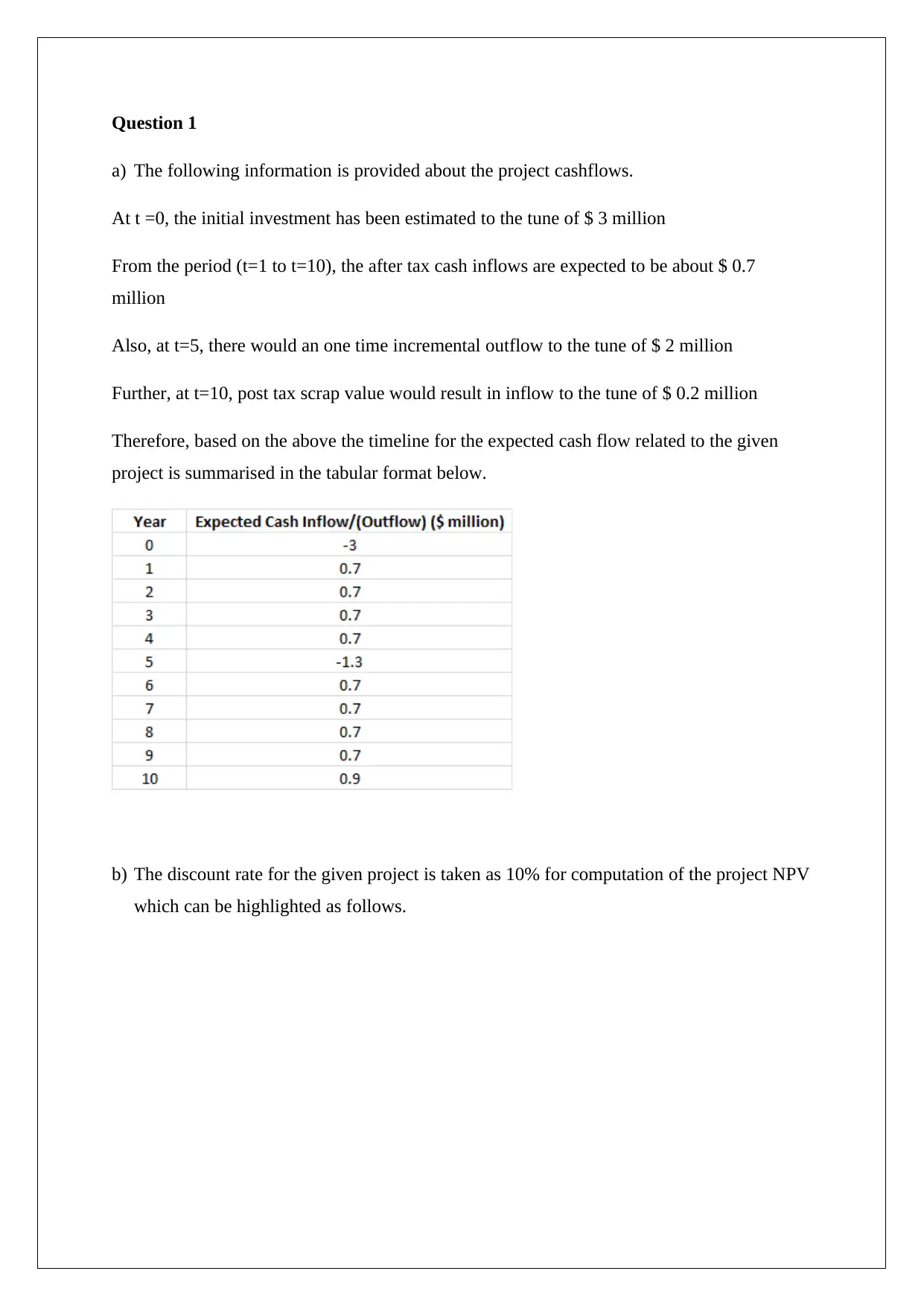
Question 1
a) The following information is provided about the project cashflows.
At t =0, the initial investment has been estimated to the tune of $ 3 million
From the period (t=1 to t=10), the after tax cash inflows are expected to be about $ 0.7
million
Also, at t=5, there would an one time incremental outflow to the tune of $ 2 million
Further, at t=10, post tax scrap value would result in inflow to the tune of $ 0.2 million
Therefore, based on the above the timeline for the expected cash flow related to the given
project is summarised in the tabular format below.
b) The discount rate for the given project is taken as 10% for computation of the project NPV
which can be highlighted as follows.
a) The following information is provided about the project cashflows.
At t =0, the initial investment has been estimated to the tune of $ 3 million
From the period (t=1 to t=10), the after tax cash inflows are expected to be about $ 0.7
million
Also, at t=5, there would an one time incremental outflow to the tune of $ 2 million
Further, at t=10, post tax scrap value would result in inflow to the tune of $ 0.2 million
Therefore, based on the above the timeline for the expected cash flow related to the given
project is summarised in the tabular format below.
b) The discount rate for the given project is taken as 10% for computation of the project NPV
which can be highlighted as follows.
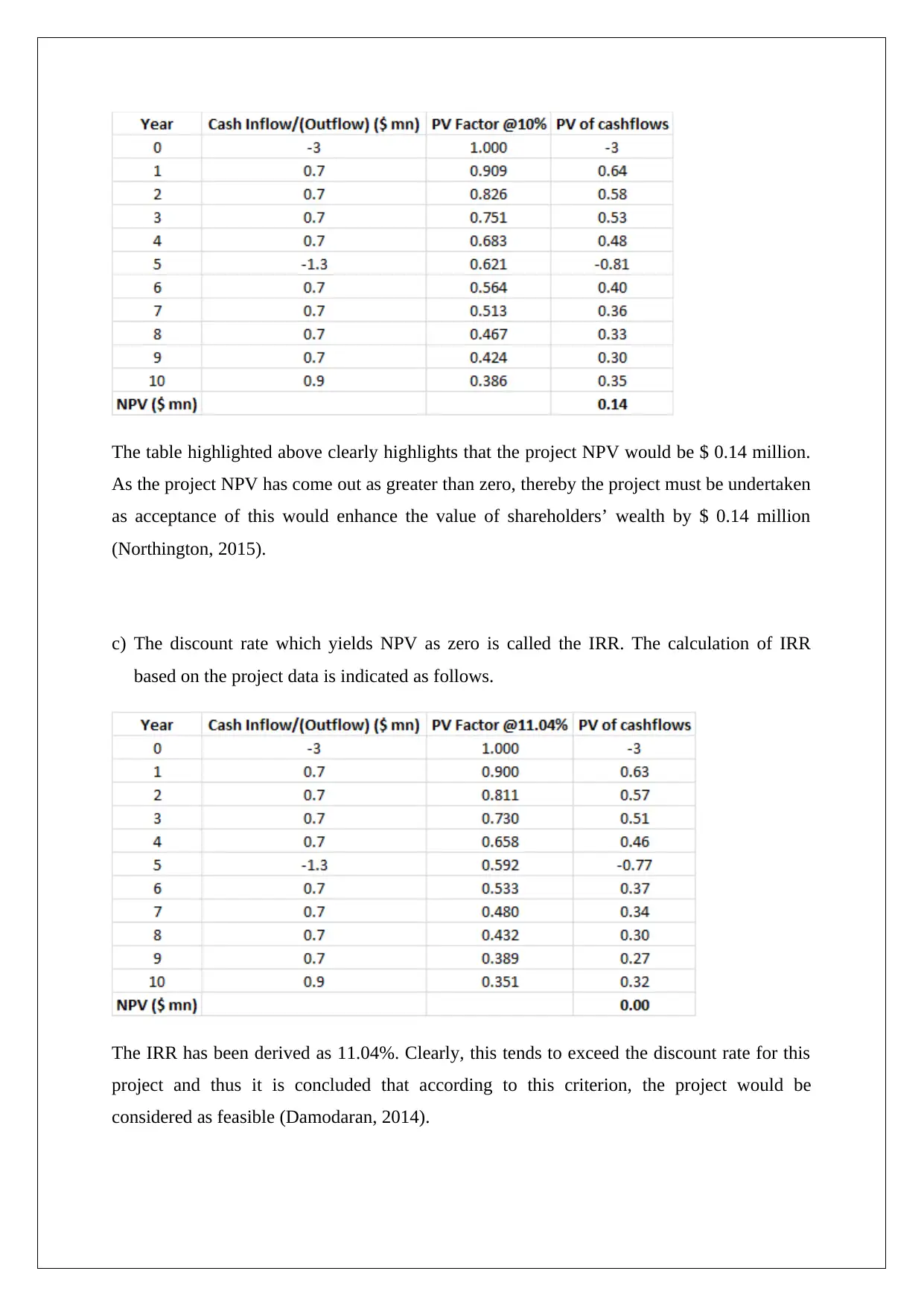
The table highlighted above clearly highlights that the project NPV would be $ 0.14 million.
As the project NPV has come out as greater than zero, thereby the project must be undertaken
as acceptance of this would enhance the value of shareholders’ wealth by $ 0.14 million
(Northington, 2015).
c) The discount rate which yields NPV as zero is called the IRR. The calculation of IRR
based on the project data is indicated as follows.
The IRR has been derived as 11.04%. Clearly, this tends to exceed the discount rate for this
project and thus it is concluded that according to this criterion, the project would be
considered as feasible (Damodaran, 2014).
As the project NPV has come out as greater than zero, thereby the project must be undertaken
as acceptance of this would enhance the value of shareholders’ wealth by $ 0.14 million
(Northington, 2015).
c) The discount rate which yields NPV as zero is called the IRR. The calculation of IRR
based on the project data is indicated as follows.
The IRR has been derived as 11.04%. Clearly, this tends to exceed the discount rate for this
project and thus it is concluded that according to this criterion, the project would be
considered as feasible (Damodaran, 2014).
⊘ This is a preview!⊘
Do you want full access?
Subscribe today to unlock all pages.

Trusted by 1+ million students worldwide
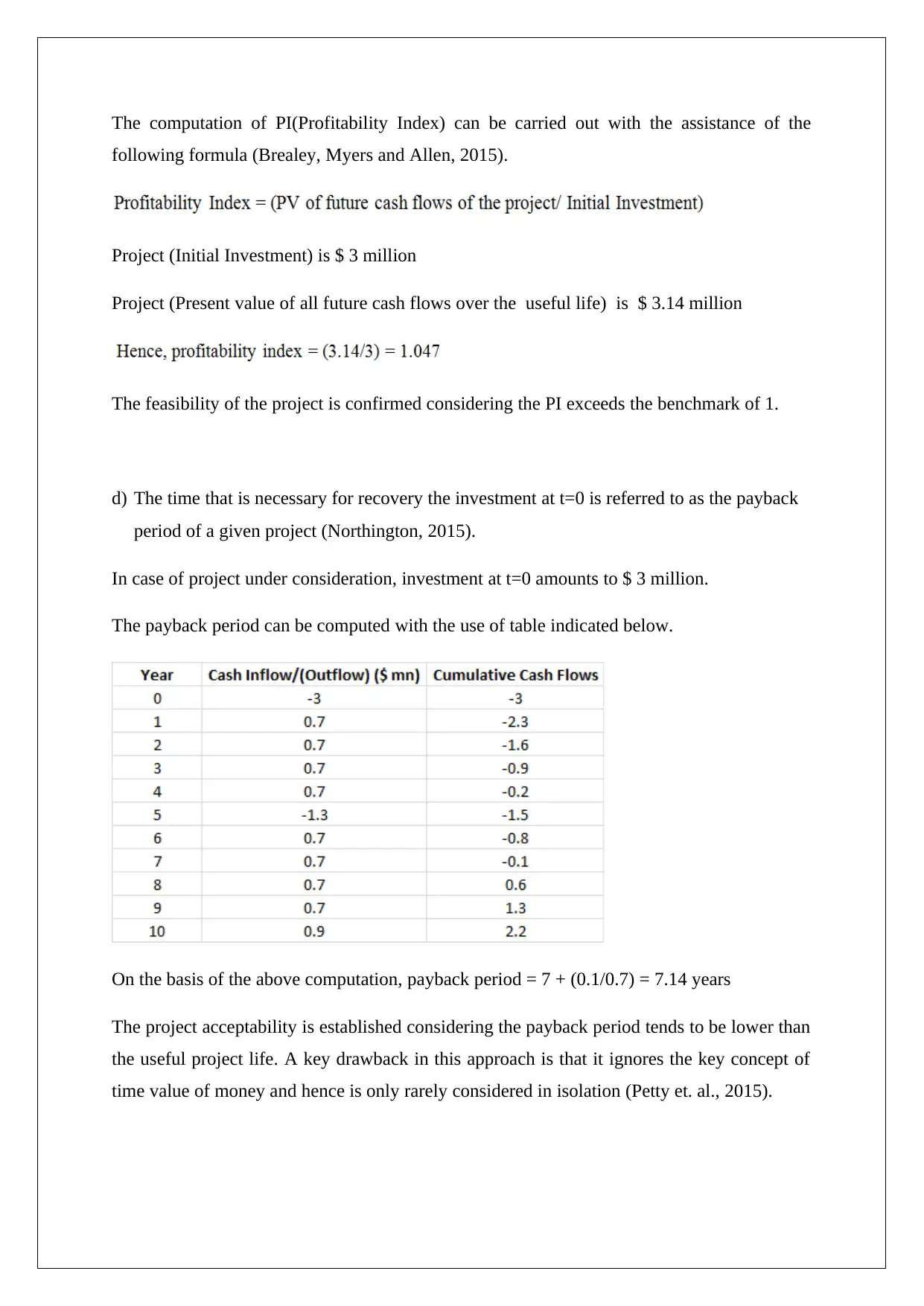
The computation of PI(Profitability Index) can be carried out with the assistance of the
following formula (Brealey, Myers and Allen, 2015).
Project (Initial Investment) is $ 3 million
Project (Present value of all future cash flows over the useful life) is $ 3.14 million
The feasibility of the project is confirmed considering the PI exceeds the benchmark of 1.
d) The time that is necessary for recovery the investment at t=0 is referred to as the payback
period of a given project (Northington, 2015).
In case of project under consideration, investment at t=0 amounts to $ 3 million.
The payback period can be computed with the use of table indicated below.
On the basis of the above computation, payback period = 7 + (0.1/0.7) = 7.14 years
The project acceptability is established considering the payback period tends to be lower than
the useful project life. A key drawback in this approach is that it ignores the key concept of
time value of money and hence is only rarely considered in isolation (Petty et. al., 2015).
following formula (Brealey, Myers and Allen, 2015).
Project (Initial Investment) is $ 3 million
Project (Present value of all future cash flows over the useful life) is $ 3.14 million
The feasibility of the project is confirmed considering the PI exceeds the benchmark of 1.
d) The time that is necessary for recovery the investment at t=0 is referred to as the payback
period of a given project (Northington, 2015).
In case of project under consideration, investment at t=0 amounts to $ 3 million.
The payback period can be computed with the use of table indicated below.
On the basis of the above computation, payback period = 7 + (0.1/0.7) = 7.14 years
The project acceptability is established considering the payback period tends to be lower than
the useful project life. A key drawback in this approach is that it ignores the key concept of
time value of money and hence is only rarely considered in isolation (Petty et. al., 2015).
Paraphrase This Document
Need a fresh take? Get an instant paraphrase of this document with our AI Paraphraser
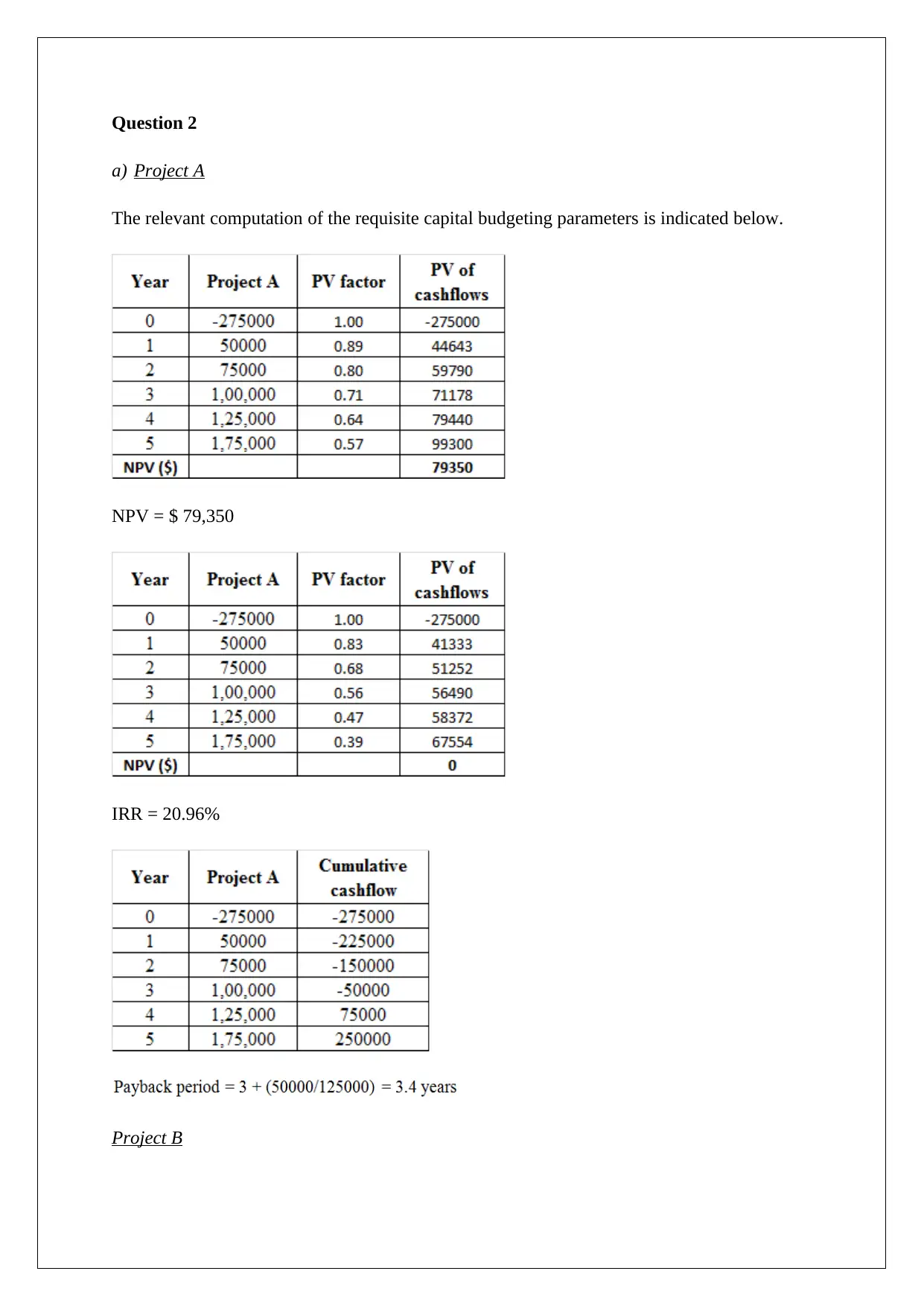
Question 2
a) Project A
The relevant computation of the requisite capital budgeting parameters is indicated below.
NPV = $ 79,350
IRR = 20.96%
Project B
a) Project A
The relevant computation of the requisite capital budgeting parameters is indicated below.
NPV = $ 79,350
IRR = 20.96%
Project B

The relevant computation of the requisite capital budgeting parameters is indicated below.
NPV = $ 85,478
IRR = 23.92%
b) With regards to NPV, both projects are able to produce a positive NPV and hence both are
eligible for selection. A similar observation can be made for IRR where each of the
projects has an IRR rate which exceeds the given discount rate. In case of payback period,
the necessary requirement is that the maximum acceptable period is 3 years. This
NPV = $ 85,478
IRR = 23.92%
b) With regards to NPV, both projects are able to produce a positive NPV and hence both are
eligible for selection. A similar observation can be made for IRR where each of the
projects has an IRR rate which exceeds the given discount rate. In case of payback period,
the necessary requirement is that the maximum acceptable period is 3 years. This
⊘ This is a preview!⊘
Do you want full access?
Subscribe today to unlock all pages.

Trusted by 1+ million students worldwide
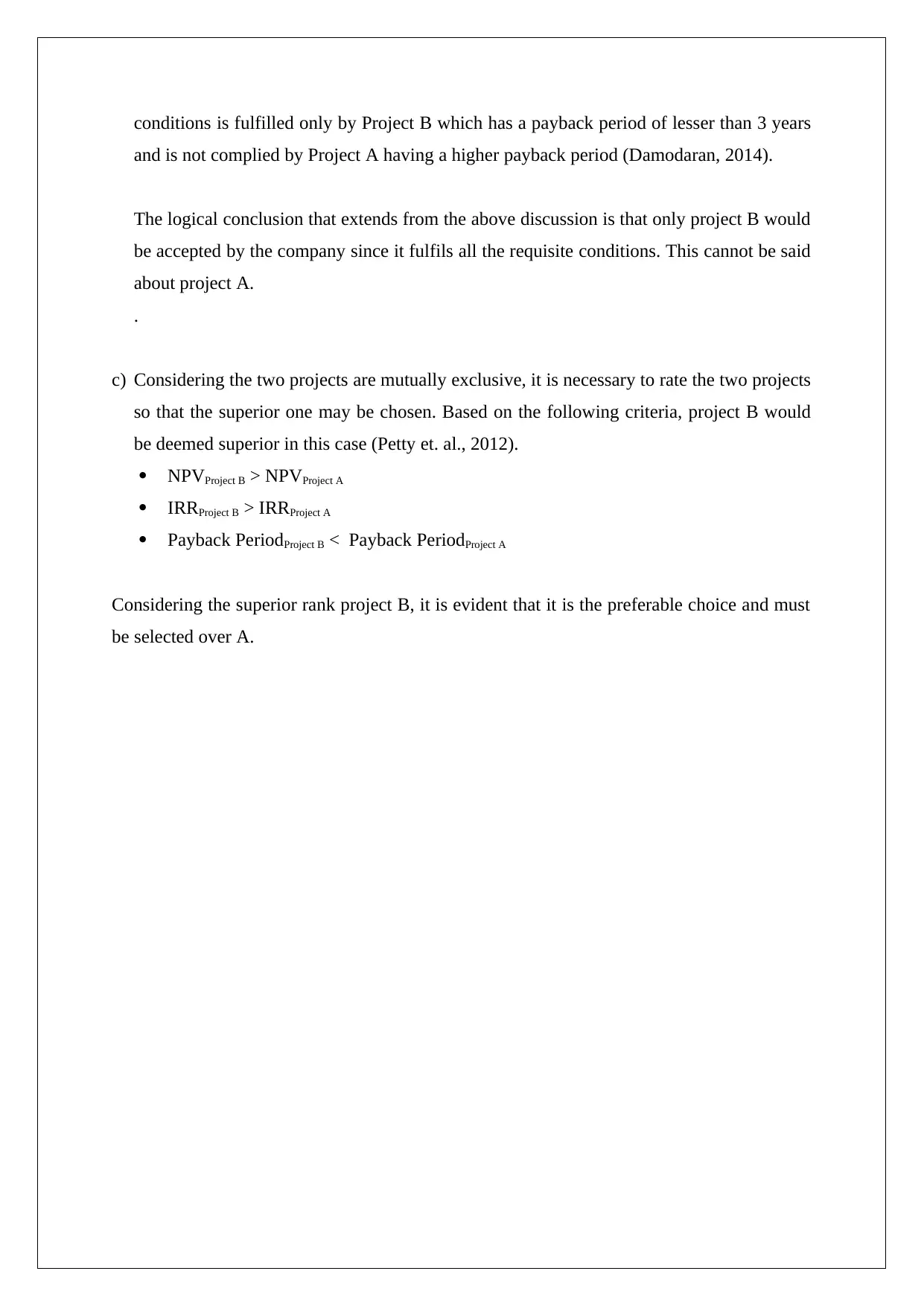
conditions is fulfilled only by Project B which has a payback period of lesser than 3 years
and is not complied by Project A having a higher payback period (Damodaran, 2014).
The logical conclusion that extends from the above discussion is that only project B would
be accepted by the company since it fulfils all the requisite conditions. This cannot be said
about project A.
.
c) Considering the two projects are mutually exclusive, it is necessary to rate the two projects
so that the superior one may be chosen. Based on the following criteria, project B would
be deemed superior in this case (Petty et. al., 2012).
NPVProject B > NPVProject A
IRRProject B > IRRProject A
Payback PeriodProject B < Payback PeriodProject A
Considering the superior rank project B, it is evident that it is the preferable choice and must
be selected over A.
and is not complied by Project A having a higher payback period (Damodaran, 2014).
The logical conclusion that extends from the above discussion is that only project B would
be accepted by the company since it fulfils all the requisite conditions. This cannot be said
about project A.
.
c) Considering the two projects are mutually exclusive, it is necessary to rate the two projects
so that the superior one may be chosen. Based on the following criteria, project B would
be deemed superior in this case (Petty et. al., 2012).
NPVProject B > NPVProject A
IRRProject B > IRRProject A
Payback PeriodProject B < Payback PeriodProject A
Considering the superior rank project B, it is evident that it is the preferable choice and must
be selected over A.
Paraphrase This Document
Need a fresh take? Get an instant paraphrase of this document with our AI Paraphraser
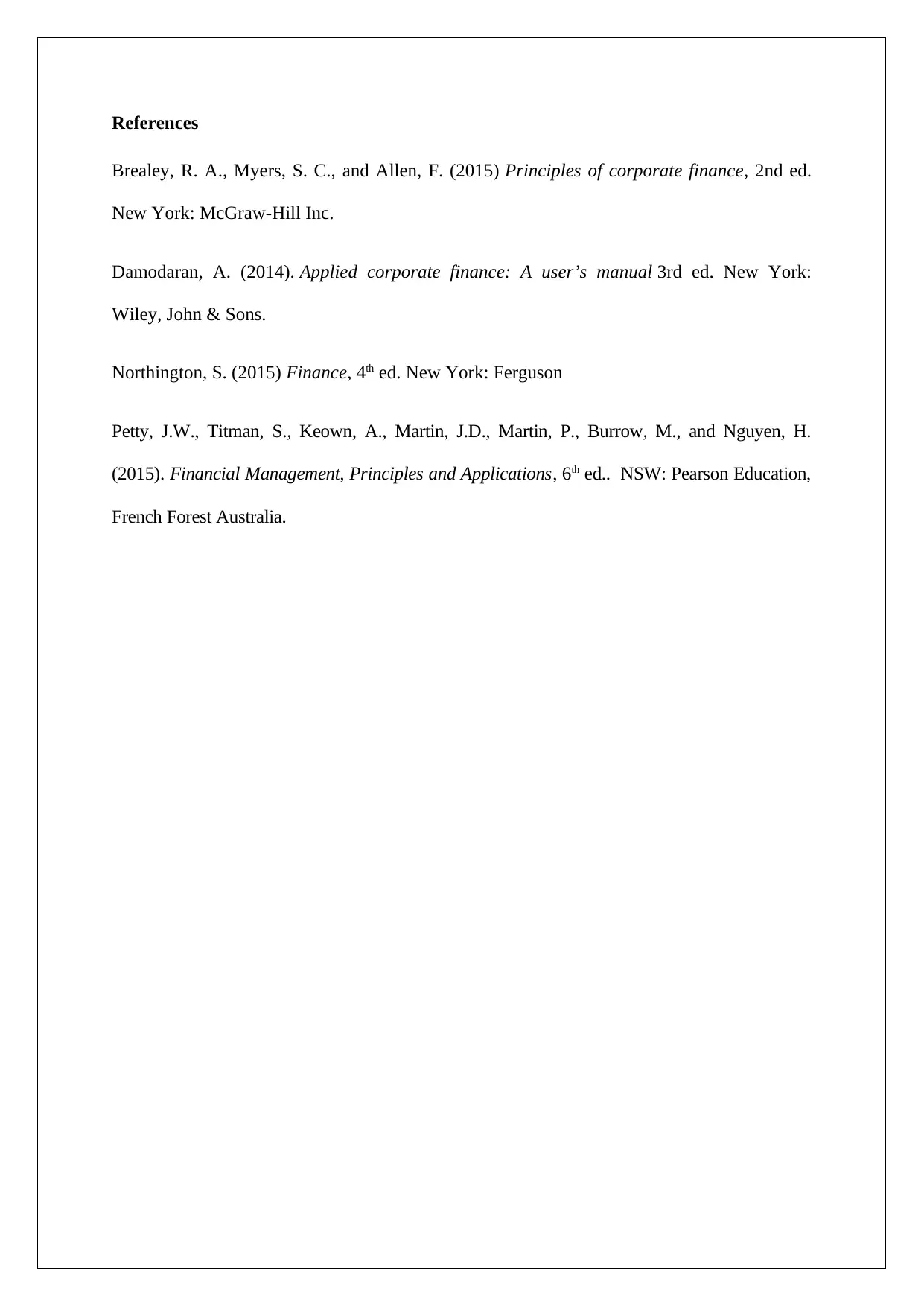
References
Brealey, R. A., Myers, S. C., and Allen, F. (2015) Principles of corporate finance, 2nd ed.
New York: McGraw-Hill Inc.
Damodaran, A. (2014). Applied corporate finance: A user’s manual 3rd ed. New York:
Wiley, John & Sons.
Northington, S. (2015) Finance, 4th ed. New York: Ferguson
Petty, J.W., Titman, S., Keown, A., Martin, J.D., Martin, P., Burrow, M., and Nguyen, H.
(2015). Financial Management, Principles and Applications, 6th ed.. NSW: Pearson Education,
French Forest Australia.
Brealey, R. A., Myers, S. C., and Allen, F. (2015) Principles of corporate finance, 2nd ed.
New York: McGraw-Hill Inc.
Damodaran, A. (2014). Applied corporate finance: A user’s manual 3rd ed. New York:
Wiley, John & Sons.
Northington, S. (2015) Finance, 4th ed. New York: Ferguson
Petty, J.W., Titman, S., Keown, A., Martin, J.D., Martin, P., Burrow, M., and Nguyen, H.
(2015). Financial Management, Principles and Applications, 6th ed.. NSW: Pearson Education,
French Forest Australia.
1 out of 8
Related Documents
Your All-in-One AI-Powered Toolkit for Academic Success.
+13062052269
info@desklib.com
Available 24*7 on WhatsApp / Email
![[object Object]](/_next/static/media/star-bottom.7253800d.svg)
Unlock your academic potential
Copyright © 2020–2025 A2Z Services. All Rights Reserved. Developed and managed by ZUCOL.




